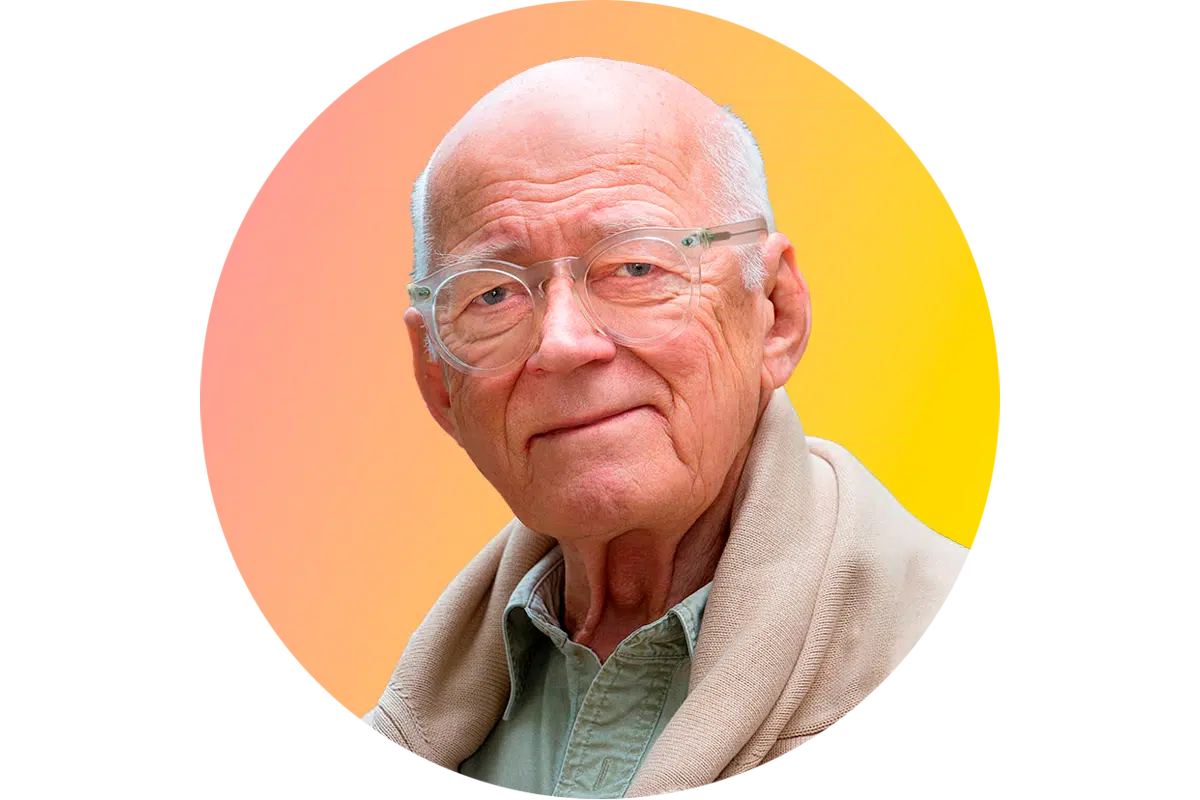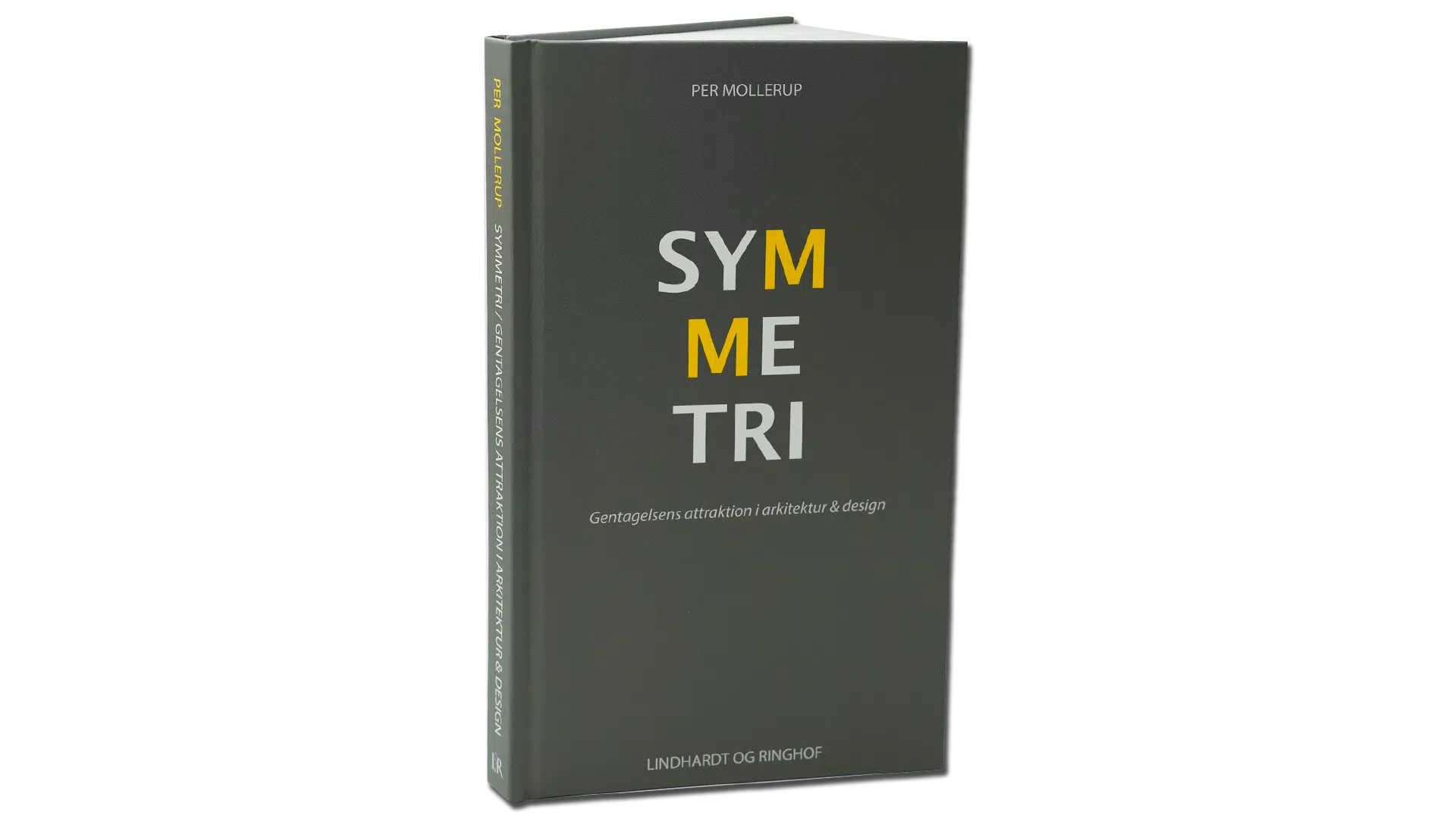
Photo: Stig Nørhald
Why We Are So Fascinated by Symmetry: Interview with Per Mollerup
By Asta Melchior Jelsing
September 25, 2023
Symmetry is everywhere. In this way, the phenomenon somewhat resembles Per Mollerup’s design work with branding and logos: You encounter it all the time, but it’s probably not something you think about daily. Meet the designer you likely already know – without realizing it.
For a lifetime, he has shaped a series of designs and logos that you have undoubtedly seen around the city. The Copenhagen Metro, The Courts of Denmark and the real estate agent Home are just some of the recognizable brands he played a role in. Per Mollerup is a man with an eye for visual appeal and a vision for symmetry. He has several prominent books on design to his name – and in his latest book ‘Symmetry’, he delves into why we are so captivated by the symmetrical in design and architecture.
How would you explain symmetry?
“Symmetry is valuable repetition, but the purpose of symmetry can be of different kinds. It can, for instance, be aesthetic: meaning, people find symmetry beautiful. Aesthetic is what people usually think of when we talk about symmetry. But there are other aspects that I find far more important, like the practical aspect and the natural one. These two aspects are more interesting than aesthetics, which is quickly addressed.
Practical symmetry can also be termed economic symmetry. When you draw something symmetrical, it’s already complete when you’ve drawn the first half. Before computers, furniture architects often just drew half a chair. They would show it to the manufacturer, who well understood what the other half would look like. It’s also cheaper to produce a chair that is identical on both sides.
The entire industry is built on modular repetitions, and modules are nothing but symmetry in two or three dimensions. Symmetry, symmetry, symmetry. There’s no construction without symmetry. You might create an asymmetrical house, but the bricks will be symmetrical. You won’t find a place where there isn’t enormous saving associated with symmetry. It’s simply the basis of all industry.
Natural symmetry is about what’s determined by nature. What’s up and what’s down is determined by gravity. What’s front and back is determined by movement. Finally, there’s sideways – and nothing determines that. Hence, one side often mirrors the other. That’s why we constantly have left/right symmetry and very rarely up/down symmetry. It correlates with the fact that all forward-moving animals are constructed the same way. We also design forward-moving vehicles that way.
The main rule for all design is that if there’s no reason for anything else, it becomes symmetrical. When you break the natural symmetry, it’s because there’s a reason for it. For example, there’s a reason that the driver doesn’t sit in the middle of a car. They need to get in and out of the car and be able to stick their head out the window to grab a ticket.”
How do humans perceive symmetry?
“We perceive it all the time. For example, we prefer faces that have some symmetry. If they are perfectly symmetrical, there’s something boring about them, and if they are very asymmetrical, we think they are ugly.
Asymmetry is an exciting part of the narrative about symmetry. Your hands are asymmetrical individually but together they form a symmetrical pair. The same goes for your ears, eyes, and feet. They are asymmetrical, but they exist in symmetrical pairs. Something similar applies to design and architecture. There are two kinds of symmetry: One where the individual thing is symmetrical and one where two or more things are symmetrical as a set.”

Per Mollerup (b. 1942) is a designer, author, and professor emeritus. He has been the editor of the design magazine Mobilia and director and owner of the design studio Designlab. He holds a doctorate from Lund University and has been a professor at the Oslo School of Art and Design and at Swinburne University of Technology in Melbourne. Throughout his career, he has written numerous books on design – the latest is titled ‘Symmetry, The Attraction of Repetition’.
What’s the historical perspective of symmetry?
“All the historical styles up until modernism had symmetry on the agenda. People made completely symmetrical houses. Not just the front, not just the facade, but also the content. When people talk about symmetry in architecture, they always think about facades, not the plan. It’s far rarer to have a symmetrical plan. An example of this is the now-demolished Palladium cinema in Copenhagen. When you entered, there was the same thing on the right as on the left.”
What happens when things are not symmetrical?
“A great architecture critic, Christopher Alexander, once said that architecture is about making a lot of small, individual things and then assembling them into a complex whole. Symmetry is simplifications that can be assembled into an asymmetrical whole. If you look at well-known architecture around the world, you can see that an asymmetrical whole with lots of symmetrical parts is a good recipe for a lot of houses. It’s not a cookbook recipe where you can just say, ‘we’ll do it this way’. But if you look at the finished result, it fits a terrible lot of houses.
Most symmetry just arises. There’s nobody saying they want to make something symmetrical. It arises because it’s a natural thing. If you make something with your hand, it might turn out symmetrical if there’s no reason for anything else. Highly likely.”
Are you constantly aware of symmetry?
“Not at all, no more than anyone else. Now, of course, I am because I know the different categories. When I see Our Saviour’s Church, I see that the spire is conically screw-symmetrical and right-handed. I see that now. I can no longer see a tower with a spiral staircase without thinking about what it is.”
You might know Per Mollerup from …
Home – name and graphics
“The funny thing is that we later got a task for a small real estate agent over on Funen, which was owned by Middelfart Savings Bank. We suggested they should be called: Come Home Safely. Since then, I can see that Home has taken it over. Now they write: Home – Come home safely.”
ARoS – name
“When we had a meeting with the board of Aarhus Art Museum and were to tell them that the new name would be ARoS, we emphasized that ARS is art in Latin. They thought that was funny. There’s not a single visitor who ever discovers or thinks about that, but it’s the kind of thing that brings it home.”
X Bus – name and color
“There wasn’t a single blue bus in Denmark, and these buses ran criss-cross through Jutland and ‘extra’ fast, and ‘extra’ comfortable, and all sorts of x. That’s why we called them x-buses.”
Other notable designs include the Copenhagen Metro, DR1, and the insurance group Codan.

‘Symmetry, The Attraction of Repetition in Architecture and Design’ is narrow in both form and subject, and its pages are filled with symmetry in all its forms. Per Mollerup covers a wide range, demonstrating that symmetry is much more than just repetition. It can be aesthetic, practical, and natural, among other things.
The book presents symmetry as a significant source of wonder and admiration. Symmetry is so attractive that architects sometimes ‘cheat’ for its sake; Greek temples had a false back entrance due to symmetry, and Amalienborg and Marienborg have fake windows for the same reason.